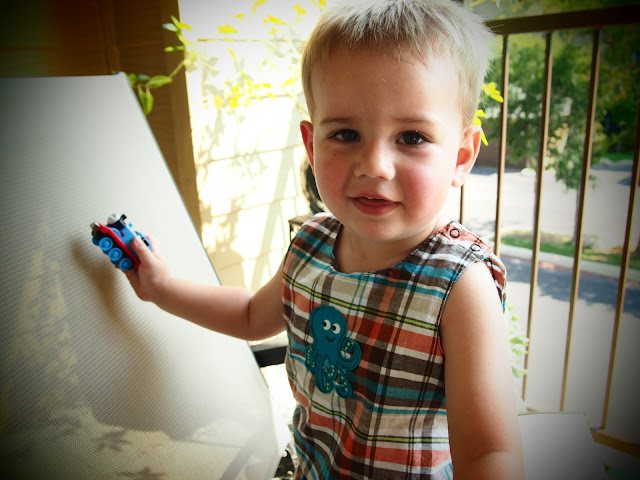I spent this past weekend at Dell Children's Hospital in Austin working with a group of people from the
Safe Kids Worldwide organization. A coworker and I were taking a class to become certified Child Passenger Safety Technicians. What did we learn? Everything you could ever want to know
and more about car seats, automobile air bags, seat belts, etc. I was really kind of shocked at how little I knew about car seats. A car seat...a piece of equipment that is designed to keep our children safe while riding in cars.
HOWEVER, CAR SEATS ONLY DO THAT IF THEY ARE USED CORRECTLY, AND 4 OUT OF 5 PEOPLE USE THEM INCORRECTLY!
4 out of 5 people use car seats WRONG? Yes. Let me explain this with an example. When I finished the class, I checked Logan's car seats in 4 cars and a friend at work...
My car: Correctly installed, but did need to be tightened slightly.
Mom's car: Seat belt installed through the wrong belt path (fed through path for rear-facing seat, but he is forward facing).
Mimi's car: Belt locking clip being used when not needed, and being used incorrectly.
Ian's car: Seat belt installed through incorrect belt path.
Friend at work: Using seat belt AND lower latch hooks in car, but not using the top tether strap.
So there you have 5 people and 4 incorrect car seat installations. I can't give you the entire dos and don'ts to car seat installation, but I can give you a few tips here to be sure you children are riding safely in you car, just in case you get in a crash. Remember, just because you are a good driver doesn't mean you won't get into a crash. There are a lot of terrible drivers out there and they don't know that you have precious cargo in your car! If you are really unsure about the installation of your car seat, you can check out the Safe Kids website to find a Car Seat Check Event in your area. They will check your seat to be sure your child is riding safely.
Quick Car Seat Installation Tips:
1. The American Academy of Pediactrics (AAP) and Safe Kids recommends children ride rear-facing until they are 2 years old, and a rear-facing seat should NEVER go in the front seat.
This seems crazy to stay rear-facing for 2 years and I thought so too until I watched some of the videos of crash testing done with rear-facing vs forward-facing. My kids will be riding rear-facing for sure! YouTube these videos...seriously. You hear people complain that the child's legs are too long. Not a big deal! They can sit with their legs crossed if they want...the moral of the story is that broken leg = cast it, broken neck = casket.
2. In a rear-facing seat the shoulder straps of the harness should be BELOW the shoulder, while in forward-facing seats the shoulder straps should be ABOVE the shoulder.
This is very important in a crash. The seats will not protect the child as they should if the are not placed in the correct slot on the seat.
3. The straps should be TIGHT and the chest clip should be at armpit level.
You should not be able to pinch any slack on the straps. You basically should be able to get one finger between the strap and the child's shoulder.
4. For correct installation of the car seat you must READ THE MANUAL OF THE CAR SEAT AND YOUR CAR!
The car manual has an index, use it! Look up the section on Child Safety Restraints and Air Bags. Your manual will tell you if there are any special considerations concerning the placement of car seats in your car and how to use the LATCH system (those are the hook at the base of the seat and that hook in the back behind the head rest.) Many people do you realized the the LATCH system in every car has a weight limit! If you car manual doesn't specify a weight limit then DO NOT USE IT IF YOU CHILD IS GREATER THAN 40 POUNDS! The car seat manual also has great information about the proper use of the car seat. For example, in baby carriers there is a typically a specific position that you should keep the carrier handle while the car is in motion. Did you know that? You might be doing it wrong...READ YOUR MANUAL!
5. If you use the LATCH system DO NOT also use the seat belt. One or the other!
If you have a forward-facing seat always use the top tether strap (the long strap dangling from the back of the seat near the head...it attached somewhere behind the headrest or at the back base of the seat in a hatchback). Always use it if your child is forward-facing!! That strap could be the difference between a head injury and being safe!
6. Texas law states that a child must be in a booster seat until age 8 or 4 foot 9 inches tall.
To many people this seems ridiculous, BUT until your child is 4'9" the seat belt doesn't fit right. It really doesn't matter how old they are...you should keep your children in booster seats until they are 4'9" or the seat belt fits properly. For the seat belt to fit properly the child MUST be able to sit in the seat with the butt where it should be and the knees bending at the edge of the seat (the calves can't be sticking out) and at this seating positiong they seat belt should strap should be across the shoulder (not hitting them in the face...not tucked behind the back or under the arm.) This is for their SAFETY! If your child is not in a booster and the seat belt is lying on the face then guess what will happen in a crash. Well, don't guess because it is not good. On a side note...keep your children in the back seat until they are over 12! Yes, until they are teenagers. You would be amazed the pressure that an airbag can exert on a child's body.
Are you all confused? Did you realize what all was involved in child passenger safety? I didn't either, but I do now! That means I will be doing my best from now on to be sure that every child I know is riding safely! If you have any questions, send me an email or give me a call!
Here is a video I found on youtube about the importance of rear-facing car seats. It is great...watch it please and pass it along!























